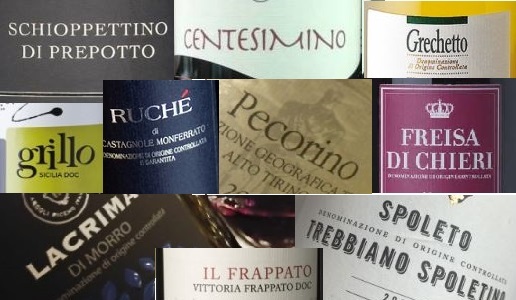What native varietals for the future?

Italy has varietals that may be little known but have characteristics that are in great demand: intense and distinctive aromas, non-redundant structures and drinkability.
Italy is an old country, both because of how long it has been around and because of how slow change comes. Anything new scares people and is fought tooth and nail in order not to be forced out of one’s comfort zone. Italy’s world of wine is very traditionalist, this in regard to production but even more to sales and the mentality of wine merchants and restauranteurs. Even worse is the traditionalist mentality among wine critics who remain stuck on certain varietals and territories based on a tradition that is, in reality, often more myth.
I often travel abroad for work and I love to go to wine shops, restaurants and similar places to see what the wine scene is like. The perception abroad of Italian wines is very different than what Italians believe. Consumers are curious to try different things and look towards emerging markets and varietals with particular characteristics. They like white wines that are very fragrant and, possibly, well-defined. Thus wines made from Sauvignon, Viognier, Riesling, Gewürztraminer and Chardonnay. The latter, I’ve been told, is on the decline, especially away from meals, but remains the most popular.
Italians find it almost impossible to break from the myth that wine should be drunk only with meals but abroad this is very common to do, above all in those Anglo-Saxon countries that are great Italian wine importers. The choice of international white wines with the above-mentioned characteristics of recognizability, fragrance, a nice acidity and not too alcoholic is quite limited. The question thus arises of whether there is room abroad for Italian whites with similar characteristics. In an editorial a while back, Daniele Cernilli observed how Italy is not viewed abroad as a white wine producer. While this may be true, I believe it is a problem of approach and the wines offered. Since they are little used at the table, classic Italian whites have difficult offering the characteristics demanded by the market. However, recent technical advances and the recovery of certain varietals should allow Italy to easily meet these demands. For me the best varietals to meet this challenge are the following, even if I may miss some: Grillo in all its bolder, thiolic versions; Grechetto, which needs some work on its phenolic side, even if it works well as an aperitif thanks to this characteristic; Trebbiano Spoletino; Vermentino, in its fresher and more traditional versions; and Pecorino, a great varietal from Marche and Abruzzo that is still undervalued. Then there is Moscato that when made as a dry wine and is not too bitter can give great satisfaction thanks to its terpenic aroma.
The problem is more complicated for red wines and this because aside from the giants – Brunello di Montalcino, Barolo, Amarone della Valpolicella and the phenomenal Etna wines - they do not command the right price, even for the historic wines, due in part to a lack of media attention. It is useless to boast about a wine’s history or importance if the market will not pay more than three euros a liter for them. For sure, Italy cannot abandon tradition and certain varietals that are part of its history, but bringing back certain forgotten varietals could be revitalizing and serve as a bridge towards a better and more profitable future for certain areas.
These Italian red varietals are fragrant, not too tannic, or at least have manageable tannins, and are not too concentrated and this is an asset for Italy. And while they have been and remain low-productive varietals, easily subject to disease and need attention in the winery, thus not suited for old winegrowing methods, now that drinking wine has become more hedonistic, they can and must be brought back. At first, the quantity will not be great but even before they reach a critical mass in order to tackle the market, other problems and prejudices must be resolved. For example, I once heard an established restauranteur in Romagna say: “I like that varietal but I don’t know how to pair it so I don’t buy it”. This is a classic mentality for a fast-food establishment but not a true restauranteur who, when he finds a fantastic wine, invents something new rather than just re-proposing his grandmother’s recipes. Furthermore, let’s say you are in an area that is fairly well-known and expanding and you cultivate Sangiovese. How much can you sell it for? Even if it is good, buyers will put you in a price range below the more famous wines from other appellations even if made with the same varietal.
In other words, using a native varietal with characteristics that meet the demands of foreign markets will allow you to break away and adequately position a new wine on the market. His is an opportunity that should be exploited. Italy has varietals with assorted yet very interesting aromas that produce very drinkable wines, those ideal not only for foreign consumers but also young Italian ones. In this year’s edition of The Essential Guide to Italian wines, for the first time we awarded prizes to two varietals with these characteristics because they have reached a stylistic and interesting maturity. Two wines and varietals that proved to have an unexpected propensity to age and this was a lovely surprise. The varietals were the Sicilian Frappato and Romagna’s Centesimino but the same could be said of Lacrima di Morro d’Alba (very fragrant), Vernaccia di Serrapetrona (made untraditionally fresh ad very spicy), Schioppettino from the area if Prepotto (very peppery), Freisa di Chieri and Ruché. The problem is that good quality is not yet widespread and these wines are little known and often criticized by conservative Italian experts. But I am convinced that working in this direction will produce great results in the near future.

 Italiano
Italiano







